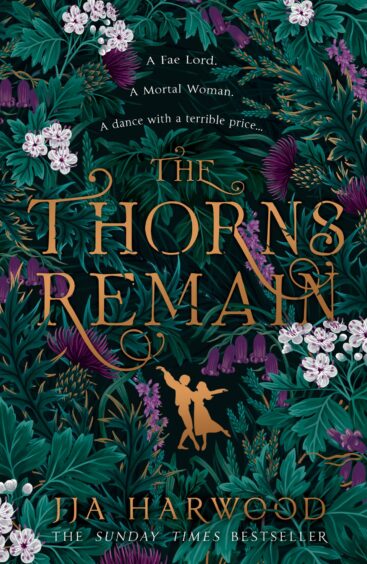After the success of her debut novel The Shadow in the Glass, we caught up with JJR Harwood to find out more about her latest book, The Thorns Remain.
Jo Harwood had been hankering after a fact-finding mission to the Scottish Highlands for many years, when lockdowns and travel restrictions finally eased off, she was rewarded with a journey that helped her to put the finishing touches to a new novel.
“I had been coveting a trip to the Highland Folk Museum and wistfully staring at pictures of Rothiemurchus for about two years before I got there,” she admits, “so it was so nice to see everything in person!”
The Thorns Remain is deeply rooted in traditional folklore, a subject that has fascinated the author since she was a little girl. “I was one of those kids who was really into mythology, so growing up I had a serious Celtic folklore phase,” she explains.
“But as I got older I started to think more deeply about it, and I realised just how much gets reflected in traditional fairy tales and mythology. My background is in history and one of the things which I’ve always been really interested in is the use of unconventional sources – so looking at architecture or landscape as a historical source rather than just relying on books.”
She was drawn to Scottish folklore, especially it’s more frightening tales. “There’s a thread of darkness in a lot of traditional Scottish myths which draws me like a magnet!” she laughs.
Looking more closely at the links between these unconventional sources in the context of Scottish folklore, Jo says that she; “realised that these tales were a reflection of the times in which they were told. There’s a lot of creatures in Scottish folklore that are closely linked to the weather, or to the landscape, and there’s a school of thought among folklorists that these kinds of stories function as a way to warn people to stay away from dangerous places or keep clear of storms.”
Keeping the tales alive
She believes that, “It’s really important to keep these kinds of stories alive, because they reflect the concerns of the people who originally told them – and considering we don’t always have more traditional historical records available, these stories are a really crucial source.”
Despite the fact that she doesn’t have a personal connection to the Highlands, Jo’s long-term aim is to make the move to Scotland and she knew that was where she wanted to base her book. “I knew that the Highlands would be the perfect setting for it, right from the beginning. When I originally came up with the idea for the story, I knew I wanted it to be about loss and grief, remembering and forgetting, what you can take with you and what you must leave behind.
“After the devastation of the Clearances, these are all things which are physically written onto the landscape of the Highlands – a whole other way of life and the way people tried to snuff it out is reflected in the remains of all the crofts and townships you can still see in the Highlands today. What better place to set a story like Thorns?” she enthuses.
Moira Jean
The action in The Thorns Remain revolves around Moira Jean, a character who was a complete change of pace from Jo’s previous heroine, Eleanor. “Whereas Eleanor was a very prim and proper schemer, Moira Jean was much more relaxed, much less patient, and just generally more inclined to have fun and cause problems,” says Jo.
“But in other ways, I wanted her to be a very vibrant kind of character precisely because she was grieving. She is fierce and proud and full of life, and because of that she really struggles to admit how much she is hurting. I’d say that definitely made her more vulnerable when it comes to The Dreamer, but with a villain that manipulative, they were always going to find her weak spots!”
The Thorns Remain also tackles the subject of the Spanish ‘flu pandemic that ravaged so many communities at the end of the first world war. Was it a coincidence that Jo had chosen that focus in light of the 2020 Covid pandemic? “I have a very clear memory about this from when I first started researching for Thorns,” says Jo, “it was about 2018 and I was sitting in a pub, waiting for a friend to arrive and reading one of my research books. I’d already decided that I wanted to set it right after WWI, and I remember thinking to myself “I guess I’ll have to talk about the Spanish flu as well, but I don’t think it’ll be that important.”
Spanish flu
“And then the pandemic happened. Talk about tempting fate! I knew I wanted this to be a story about grief and to have a bereaved main character, so setting the story at a time of mass loss felt like a very natural choice. But the Spanish flu added an interesting dimension to the story which I hadn’t really considered before, because it was an enormous series of mass deaths, but before the Covid pandemic people didn’t really seem to talk about it all that much. I kept wondering why one traumatic event was remembered and another was forgotten, when the two were very much interlinked.”
Now that The Thorns Remain is out in the world, Jo says that a new imprint of her novel has also been causing a stir. “There’s been a lot of excitement over the absolutely gorgeous Locked Library edition,” she enthuses, “which has a different colour palette and some incredible printed edges, and it’s been so lovely seeing something I’ve written get turned into something so beautiful – and that readers are getting really excited about, too!”
So what’s next for JJA Harwood? “I am working on something new but it’s very early days, so I won’t say too much. I’m having a lot of fun on this next project and I can’t wait until I can share more info!”
The Thorns Remain, JJA Harwood, Magpie, £16.99.












Conversation